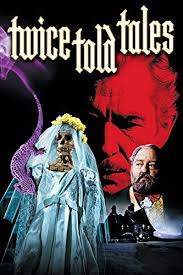
The film contains three stories, all starring Vincent Price, all introduced by him, and all based on stories by Nathaniel Hawthorne. In Dr. Heidegger’s experiment, two elderly friends, Doctor Carl Heidegger (Sebastian Cabot) and Alex Medbourne (Vincent Price) meet to celebrate the former’s 79th birthday. They discover that Heidegger’s former fiancée, Sylvia Ward (Mari Blanchard), is perfectly preserved in her coffin. Heidegger’s theory is that something in the water that has been dripping into the coffin all these years has preserved her. He dips a withered rose in the water and it comes into full bloom.
Carl and Alex drink the water and become young again. Carl injects it into Sylvia and she comes back to life, but it is revealed that she and Alex were secret lovers and Carl attacks him. Alex kills him in self-defence. The effects of the water wear off and Sylvia is reduced to a skeleton. Carl’s dead body returns to its original age. Alex runs to the crypt for more water but it is no longer running.
In Rappaccini’s Daughter, Giacomo Rappaccini (Vincent Price) of Padua, keeps his daughter Beatrice (Joyce Taylor) locked up in a garden. A University student named Giovanni (Brett Halsey) sees her and falls in love. One of his Professors (Abraham Sofaer) knows Rappaccini and says that the man abruptly quit the university and became a recluse when his wife ran off with a lover. We learn that he has treated his daughter with an exotic plant that makes her touch poisonous, to keep admirers away. Beatrice tries to commit suicide, so Rappaccini doses Giovanni with the extract that gives him the same deathly touch so that Giovanni and Beatrice can touch each other but no-one else. But Giovanni has obtained an antidote which he consumes in front of Beatrice. It kills him and, distraught, Beatrice drinks it too and also dies. Rappaccini grabs the plant with two hands and dies as well.
In The House of the Seven Gables, Gerald Pyncheon (Vincent Price) returns to his ancestral home after 17 years, bringing home his wife Alice (Beverly Garland). His sister Hannah (Jacqueline deWit), who has been living in the house, tells her about the family curse placed upon them by Matthew Maule, who lost the house in a deal gone wrong. Maule’s descendant Jonathan (Richard Denning) arrives but refuses Gerald’s offer to give him the house in exchange for the location of the vault. Alice becomes haunted by the curse, and she and Jonathan are drawn to each other by the spirits of their ancestors.
Sleepwalking, she is drawn to the cellar. Gerald finds her there and discovers the map to the vault hidden under Matthew’s grave. He kills his sister Hannah to keep her share of the treasure and traps Alice in the grave, then goes to the study to find the vault. When he opens it, a skeletal hand strangles him and the house begins to shake. Jonathan arrives and rescues Alice from the tomb before the house collapses into rubble.
The film was directed by Sidney Salkow and written by producer Robert E. Kent based loosely on three stories by Nathaniel Hawthorne. Doctor Heidegger’s Experiment was the only one published in Hawthorne’s Twice-Told Tales. The version of The Fall of the House of Usher here is quite different from that in the 1940 full-length film, and Price’s Gerald Pyncheon is quite different from his Clifford Pyncheon in that film, which more closely resembles the original story by Poe. This film was not as well received by either the critics or the audience. The exotic sets were generally praised, but it was criticized as slow-moving and dull. Also, it was thought way too long at a full two hours (!). Beverly Garland noticed antique-collector Vincent Price examining some props on the set, which later disappeared.
